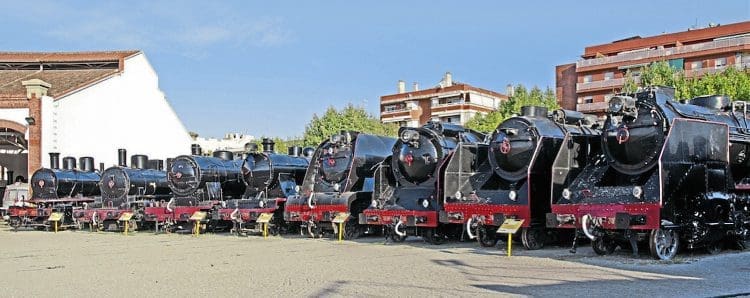Imagine a steam shed that closed, with the doors shut and locked, leaving behind a large variety of locomotives sitting over the pits and in the roundhouse? John Titlow reports on how 10 years later, with a small amount of maintenance, it opened as a museum – Museu del Ferrocarril de Catalunya, Vilanova i la Geltru.
Spain has been a very popular holiday destination for the British for many years, especially since the death of Franco and our joining the EEC. Many Brits have made it their home, especially on retirement and the most popular place in the north must be Catalonia on the Mediterranean coast, how this will change after Brexit nobody knows. Located at the eastern end of the Pyrenees it covers the areas of Girona, Lleida, Tarragona and Barcelona but perhaps it is more famous for the renowned Costa Brava.

If you Google ‘Spanish Railway Museum’, www.museodelferrocarril.org amongst others will appear, but not so obvious unless you delve considerably deeper is the real hidden gem at museudelferrocarril.org/es/ (English web site is presently under construction) the Catalonia Railway Museum in Vilanova i la Geltru, located immediately outside the station. Forty-five kilometres to the south of Barcelona on the Mediterranean coast, in this unassuming town, is one of Europe’s largest collections of steam locomotives that is not widely known about, and if you like your locomotives painted black then this is the place for you.
Enjoy more Heritage Railway reading in the four-weekly magazine.
Click here to subscribe & save.
Unusual for a national railway museum, the main Spanish one is in the capital Madrid inside the former Delicias station, where under the huge overall roof, locomotives and stock are wedged into rows. Like Shildon, Vilanova is an offshoot of the main museum but has more steam engines and space.
From 1992 both museums have been managed by the Fundacion de los Ferrocarriles Espanoles (Spanish Railways Foundation) a cultural organisation made up from the national railway companies who “work hard to preserve and publicise the importance of industrial and rail heritage”. Vilanova is also part of the Catalan Science and technology museum system.
What also makes Vilanova more poignant is its proximity to Spain’s first railway that opened on October 28, 1848 between Barcelona and Mataro. Vilanova itself had to wait until 1881 for its first train to arrive. Just to confuse, the gauge chosen was 1,674mm, around six Spanish feet (5ft 6in); this is the second widest gauge still in regular use in the world. The original reason given was that it enabled larger locomotives to operate in Spain’s difficult terrain, but various searches revealed that a possible influence was to hinder the French should they invade.
Read more and views more images in Issue 241 of HR – on sale now!
Advert
 Enjoy more Heritage Railway reading in the four-weekly magazine. Click here to subscribe.
Enjoy more Heritage Railway reading in the four-weekly magazine. Click here to subscribe.




